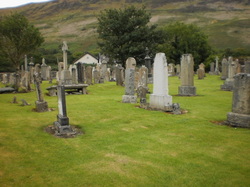
By Bridjes O'Neil
The reason I described a cemetery as unique is because of its historical value. Some of these tombstones dated back to the late 19th century. A majority of the decedents lived into a ripe old age while others were small children as young as 9 years old. Sadly, these tombstones were in bad shape as you can tell from the pictures.
Did you notice the Celtic cross? Its design truly inspired me. I would wager any amount of money that I could dig up a great story *No pun intended*. Who were these people? How did they contribute to Scotland's history? Why did some of these people prematurely die? One person in particular piqued my interest because he was lost at sea in wartime.
The cemetery is located next to St. Bride's Church of Scotland in Lochranza. Lochranza is a village located on the Isle of Arran.
Author
Bridjes O'Neil is a Broadcast & Digital Journalism student at Webster University in St. Louis, MO. Bridjes participated in a study abroad trip to Scotland for a Travel Journalism class. All photos were taken by Bridjes O'Neil.
 RSS Feed
RSS Feed